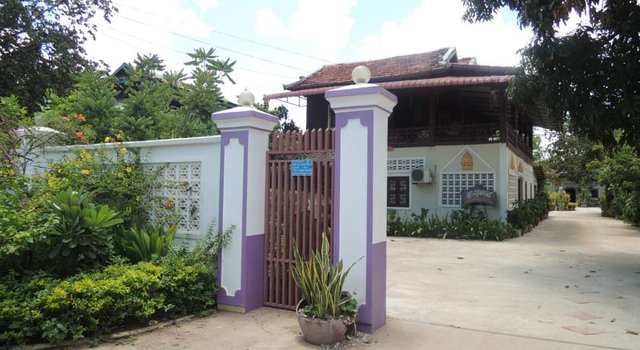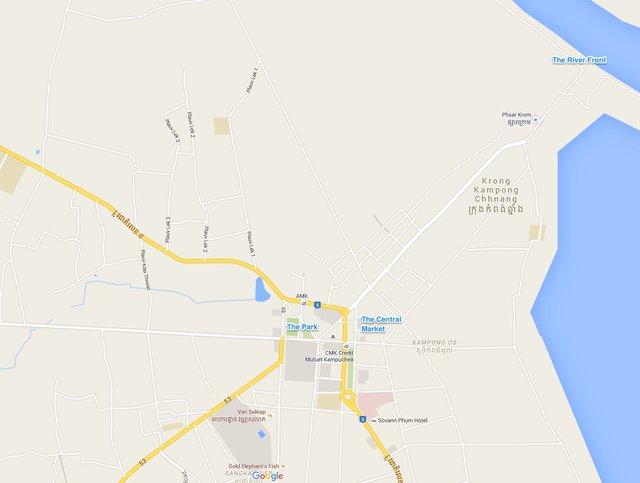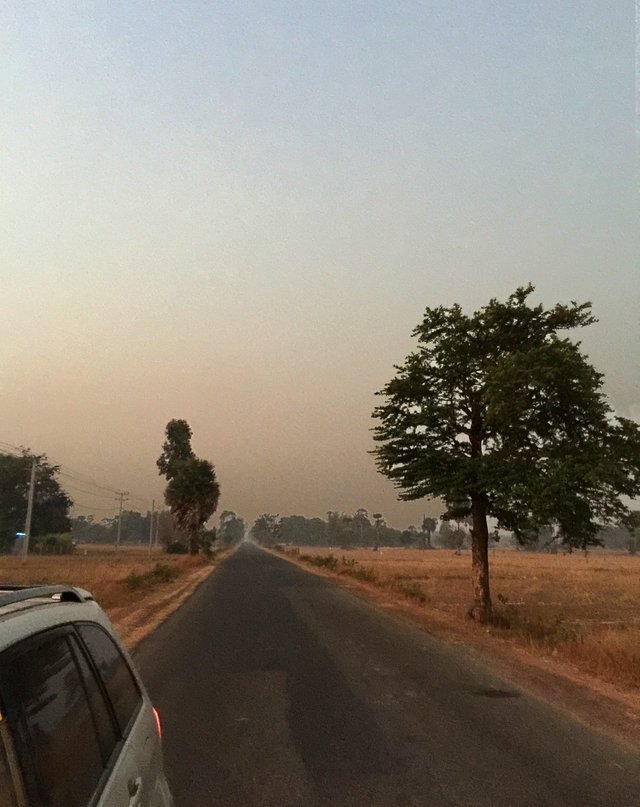Visitors Guide To Kampong Chhnang, Cambodia
Maybe you live in Phnom Penh, or you have been to the Kingdom a couple of times. Where to go on your next holiday? Angkor Wat is amazing, sure. However, how may times can you look at those temples? The beach can be fun. That is a fact. As long as you do not mind sharing it with all the meth whores, drunks and deadbeats down in Sihanoukville. Also, Battambang… well, do you really get excited about riding that bamboo train?
Now is the perfect time for a visit to the real countryside. Get off the tourist trail and go to a place where there are no banana pancakes for breakfast. A place without any peculiar attractions. Without any nightlife, beyond the few obligatory karaoke parlors. A quiet, relaxed place but not too far from Phnom Penh. Endless rice fields, countless sugar palm trees, the Tonle Sap river and not much else. Kampong Chhnang is the perfect place for a holiday. We got everything covered to make sure you do not miss a thing.
Only 90 kilometers on National Route 5 is all it takes to get from Phnom Penh to Kampong Chhnang. We recommend Garden Guesthouse in Kampong Chnnang City as the perfect getaway from the capital. Cheap, clean rooms in a tropical garden close to the town center.
Start your holiday with exploring Kampong Chhnang City. Go shopping on the local market, feed the monkeys in the park and take a stroll along the riverside. Go on a boat trip to visit the floating villages on the Tonle Sap River. Take a ferry to the far shore to hike around the Kampong Leang wetlands and climb Neang Kong Rei Mountain. Spend a day in the countryside. Explore the rice fields, gaze at sugar palm trees and climb a few hills. Take a trip to the abandoned Khmer Rouge military airport and learn something about Cambodia’s dark and tragic past. Travel on roads less traveled for a visit to an old capital or try to find a remote jungle waterfall.
Getting There And Around
National Road Nr. 5 is the main transportation corridor that runs through the province, roughly following the west bank of the Tonle Sap River from north to south. All major bus companies that travel between Poipet and Phnom Penh go through Kampong Chhnang. Just ask the driver to drop you off in Kampong Chhnang City. Alternatively, you can arrange a private taxi from Phnom Penh or any other city along Route 5. There’s also a speed boat going up and down the Tonle Sap River, between Phnom Penh and Siem Reap, that stops along the Kampong Chhnang riverside.
In town you can easily get around by tuk-tuk or explore by yourself on foot or rent a moto or bicycle.
Around Town
Psar Leu (The Central Market)
The central market is the main shopping area in Kampong Chhnang City. It is in full swing early in the morning and around sunset although it is open all day long. You will find stalls selling fruit, vegetables, meat, fish, goods for everyday use, clothing, hairdressers, etc.
The Park In Front Of The Provincial Hall
This places comes to live when the sun gets low; people come to exercise, to eat street food or just to hang out. There’s a group of monkeys living in the garden of the provincial hall, on the south side of the park. Just be careful with foodstuff around them.
The River Front
Just like the park, this place gets busy when the sun is losing its strength. People come here to eat and meet each other. It is a nice play to just hang out and observe life. You can see the famous Neang Kong Rei Mountain on the other side of the river. Maybe you can recognize the shape of a female giant lying on her side in the shape of the mountains. This is part of a famous Cambodian fairy tale: when her husband left, he created the Tonle Sap River so that his wife could not follow him. Now she waits patiently for her husband to return to her.
The Tonle Sap River
The Tonle Sap River is the only river in the world that flows upstream. The direction of the flow changes twice a year. In the rainy season, the river flows to the north (to the Tonle Sap Lake) and in the dry season to the south (to the Mekong Delta). The melting ice from the Himalaya in combination with the monsoon makes that the level of the Mekong rises strongly and part of this water will be pushed upstream on the Tonle Sap. In the dry season, the water flows back from the lake to the Mekong. In the rainy season, the area of the Tonle Sap Lake grows up to 6 times. The difference in water levels between the seasons can be up to 8 meters. The flooded land makes a perfect breeding ground for fish and makes this area a prime fishing zone. The Tonle Sap is of vital importance to the Cambodian food security.
Along the banks of the Tonle Sap River in Kampong Chhnang are two floating villages: Kandal village to the east and Chong Kos to the west. The community is completely adapted to the changing of the water level of the Tonle Sap River. Most of the village inhabitants are Vietnamese, some of the families have been living here for generations. While living on the water, they have all the amenities a mainland community has: houses, shops, vendors and even petrol stations. On the river side in Kampong Chhnang City, locals offer boat rides in small canoes around the villages.

On the other side of the river is Kampong Leang District. This is an elevated area within the Tonle Sap floodplain, which means that it is surrounded by water and wetlands most of the year. Only during the height of the dry season (March through April) a dirt path connecting Kampong Thom Province in the north is available. Already very early in history, this area was inhabited, which can be seen by the temple ruins that still exist.
The village of Kampong Leang is the main link of this district with the rest of the province. Its little port can be reached by a 30 to 60 minutes ferry from Kampong Chhnang City, depending on the season. From the village, you can reach the famous Neang Kong Rei Mountain. First, there’s a long flight of stairs followed by a small trail to the top. It is not an easy climb, but the views are amazing.
Further in the district, there are four sites containing pre-Angkor temple ruins: Punnareay, Bros, Srey and Slotey Temple. They were built between the 7th and 8th century, which makes them 400 years older than Angkor Wat. The temples were dedicated to Hindu gods.Nowadays they are in a state of ruin, they have been left without proper conversation work and are damaged over time by nature and looting. It is possible to visit them all four: Punnareay Temple lies on the top of a 140-meter high hill, Bros Temple is located in the middle of the rice fields, and Srey Temple is to be found on the terrain of a recently build Buddhist temple.
Da Seila Toukmeas cascade is another point of interest in the District. It is a natural site located in Da commune at the foot of the Kampong Leang hills. The area stays dry during the hot season, but it is a beautiful place to visit during the rainy season. Especially during Pchum Ben (the festival of the death) when many local families come here to pick-nick.
Kran Deymeas Hill
Close to National Road nr. 5, this 250-meter high hill can give beautiful views over the city of Kampong Chhnang and the surrounding countryside. You can see the typical Cambodian landscape with rice paddies, sugar palm trees, and the Tonle Sap River. The view is especially lovely in the rainy season when everything looks fresh and green. If you are able to locate a small trail, you can hike to the top. It is about a 1-hour climb depending on your fitness level and the heat. The clay of this mountain is used by the pottery businesses at the foot of the hill. The name means golden soil hill. This comes from the fact that people can turn the soil into pottery and sell it.
Pottery Village
Kampong Chhnang means Port of Pottery. It is well known for its fine clay pottery. Beside rice farming and fishing, the people of this province are making pots, vases and various other types of ceramics during the off harvest season. The quiet village of Ondong Rossey, surrounded by serene rice fields dotted with sugar palms, is where the Khmer pottery originates. Almost every household in this area is making some form of pottery. The pots are mostly unpainted but decorated with etched designs. The traditional process of making pots is fascinating to observe.
Sorntuch Mountain
This mountain is located about 3 km southwest of the city along Route 53. There are many big rocks, giving it a big contrast with the surrounding flat countryside. From the top of the rocks, you have a beautiful view over the countryside. Because of the beauty of this location many music videos are recorded here.
The Khmer Rouge Military Airport
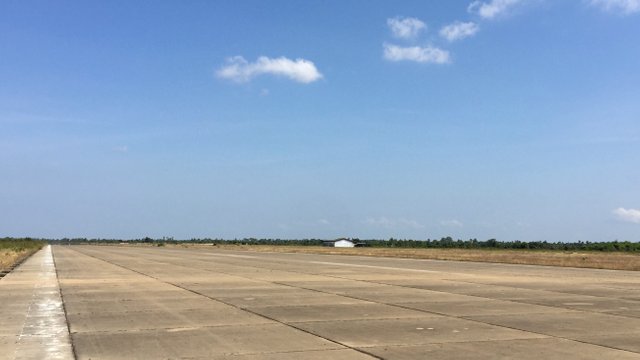
About 14 km west of Kampong Chhnang City the Khmer Rouge Regime, together with the Chinese (allegedly), built a massive military outpost. The airstrip, different buildings, a water tank and a prison cave still exist. These constructions were secretly built during the Khmer Rouge regime by forced laborers. As part of keeping their plans secret, the Khmer Rouge killed all the workers at a later stage. About 2 km west of the airport is a river where all the people were murdered.
The total airport area covers 12000 hectares, and the runway (2.4 km) is still, after 35 years, in very good condition. The airport has never been used; before it was finished, the Khmer Rouge were defeated by the Vietnamese. The runway is currently guarded by the Cambodian military, but you can ask the guards to enter. A small fee might improve their willingness.
At the foot of the hill close to the airport, there is a massive water tank, hidden in between the trees. It was built during the Khmer Rouge regime as the water supply for the airport. The nearby ruins were part of the housing used by the Khmer Rouge military. To find the water tank you should go south at the crossing of the concrete road and the airport road. This road will bend to the left. After about 150 meters there is a gravel path going to the right. Follow that path and try to find a big concrete construction between the trees at your right. It is about 20 meters high and has a radius of about 12 meters.
Along the road back to town you can find the Khmer Rouge prison cave. It is hidden in the hills, around 200 meters from the road. The cave is fortified by concrete. It is believed that this cave was constructed to either become a prison or a bunker, all proof for the real function has vanished. The cave is partly flooded during the rainy season and very muddy in the dry season. Be careful when entering. It is a favorite spot for snakes. Anyway, it is not that easy to find.
Longvek
About 50 km south of Kampong Chhnang city, along National Road 5 back to Phnom Penh, in Tralach district there’s an old Cambodian capital. Longvek became the capital after the sacking of Angkor by Siam in 1431. The first contact with European adventurers and missionaries was at this time (that is why Angkor stayed unknown to the western world for so long). Longvek lasted as a capital for almost 200 years, until 1618. No much is left from this time. So, there’s not that much to see. There are lots of big pagodas in the area. It is a nice to place to visit if you like it quiet and peaceful without much to see or do.
Kampong Preah Temple
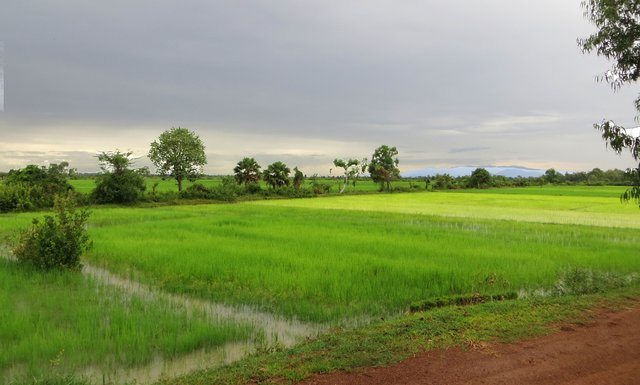
This temple is located 40 km north of Kampong Chhnang city in Baribour district, Chhnok Tru commune. It is close to the border with Pursat province. In the dry season, it is about a 1-hour drive from the city. In the rainy season, you can drive until the road turns into a river. At that point, you will want to rend a small motorized canoe to reach the place. Alternatively, if you are more a sensible person, return in the dry season. The Kampong Preah Temple is a Hindu temple built between the 6th and 8th century. It originally consisted of 3 small buildings of which one is renovated. The two others are in a state of ruin. The Kampong Preah Temple is used to describe an architecture and art style (Kampong Preah Style) with is characterized by a “temple mountain” structure and carvings in the walls of isolated figures.
Handicraft Center
There’s a local woman-run handicraft center 15 km south of Kampong Chhnang City in Roleabier District, Tuek Hout commune. Bamboo baskets, weavings, and pottery are made and sold here. All the products are made by local women with local materials. This might be an excellent opportunity to load up on souvenirs and gifts for friends while supporting the local community.
Po Rokharam Pagoda
Traveling 45 km south of Kampong Chhnang City to Kampong Tralach district, Kampong Tralach commune, you will find an old pagoda complex. It was already in use in 1672. The oldest remaining temple was built in 1847 and has remarkable paintings in the interior of the temple. Only two temples in Cambodia are decorated like this; the other one is in the royal palace in Phnom Penh. There are three stories painted in this temple in comparison to only 1 in Phnom Penh. The paintings survived all this time which is quite remarkable in a tropical climate. The paintings are unfortunately not in perfect condition anymore.
Anlong Svay Waterfall
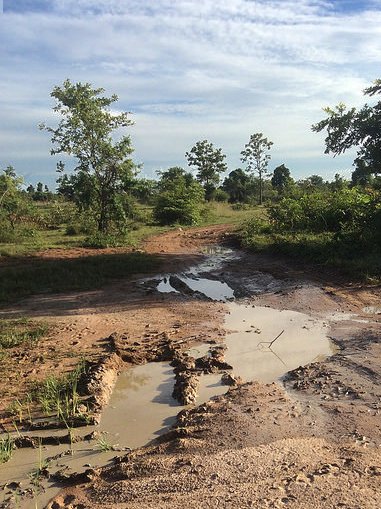
If you are looking for adventure and really want to get off the beaten path than an expedition to Anlong Svay Waterfall might be what you are looking for. It is located about 65 km southwest of Kampong Chhnang City in Tuek Phos district, Kbal Tuek commune. The journey starts with a pleasant drive down beautiful Route 53 to Tuek Phos. Beyond Tuek Phos things get complicated quickly. There are dust trails in the dry season and mud tracks in the rainy season. Opinions vary where those trails might lead to. The waterfall is located inside the Phnom Aural National Park. At one point you will have to climb a mountain. There are no facilities at the waterfall. Very few people know about it. The only way you might be able to find this place is to navigate to these GPS coördinates:
N11.978690 E104.306416
But don’t count on Google Maps to get you there. You will have lost all mobile internet somewhere while getting out of Tuek Phos City. We heard the waterfall is no even all that impressive. However, if you make it that far, you will be all alone in the middle of a dense rainforest far, far away from everything and everyone. We received reports some consider this a great adventure. Good luck!
This is an updated and complete edition of a series of articles originally published on MekongMonkey in Januray 2016

